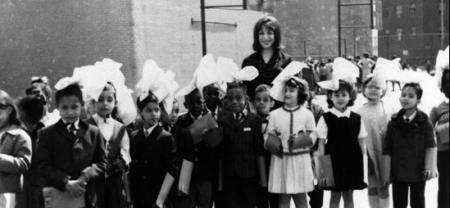The Feldman Years: From labor union to union of professionals

Sandra Feldman with her 4th-grade class at PS 34 in Manhattan, 1965.
By SUSAN AMLUNG
The current school-budget crisis is no surprise to many veteran city public school educators. Fiscal turmoil seems to assault our schools every 15 or 20 years. Typically, teachers are called upon to save the day and, for the sake of the children, they do, even though it often means personal sacrifice or risk to their own financial well-being.
For the union leader who advocates such sacrifice, it also means great political risk. Nevertheless, we saw that kind of leadership courage in Al Shanker when he put members’ pensions on the line to save the city from bankruptcy in 1975. And in 1991, we saw it in his successor, Sandra Feldman.
Sandy (as everyone called her) never shrank from a fight on behalf of UFT members, as countless politicians and school officials will tell you, but her prime motivation was always the children of New York City. Growing up in grinding poverty herself, she found hope and inspiration in her public school teachers, and as an adult she fervently believed that the public schools were poor children’s best chance for a better life.
So when, just after UFT members had celebrated a new contract with a 5.5 percent raise and 100 educational reforms, midyear budget cuts threatened the jobs of 3,500 educators, the loss of critical school services and larger classes, it was UFT members who saved the schools. In return for a no-layoff agreement, they lent the city $40 million right out of their paychecks, almost $600 each, to be repaid in 1995-96, with interest.
But Sandy’s concern for children did not mean she was a bleeding-heart type, as some expected from a UFT president who was the first female and the first elementary school teacher to hold that spot. When it came to school conduct and academic standards, she was tough, winning the first system-wide student discipline code and zero tolerance for violence policy. She fought against “social promotion” and won contractual protection against principals who compromised teachers’ standards by changing failing grades.
Nevertheless, if anything competed with children’s well-being for Feldman’s top priority, it was making sure teachers were treated as professionals. Public schools, she said, still operated on the top-down factory model, and nothing symbolized that more than the time clocks where teachers punched in and out each day. One of her first acts as UFT president was to demand their removal. It took a few years, but it got done, especially after the public ridicule when a teacher’s pay was docked for being a minute late. The penalty? Thirty-one cents!
But the drive to professionalize teaching that dominated the post-Shanker UFT was much more than symbolic. If recognition as unionists was the driving force behind the UFT’s first 25 years, then recognition as professionals drove the union’s second 25 years.
The Feldman era is noted for its spate of education reforms. Less recognized is that, in addition to improving children’s education, those reforms also enhanced teachers’ professionalism. Teacher’s Choice, won in 1986, gave teachers access to supplies that professionals took for granted. Mentoring, the Peer Intervention Program and the expansion of Teacher Centers gave teachers responsibility for maintaining professional standards. School-based Options, School-based Management/
Shared Decision-making and Professional Conciliation, all instituted in the 1987 and 1990 contracts, gave teachers voice in shaping their professional lives. And lesson plans that did not have to adhere to a prescribed format or be routinely reviewed by the principal showed respect for their professional judgment.
Not all professional issues had to do directly with teaching. As school buildings began to show the effects of deferred maintenance after the fiscal crisis, the union made the physical environment a critical part of the basic working conditions that professionals are entitled to.
The challenges were immense. As paint peeled and plaster crumbled, loose asbestos became a hazard, closing schools for weeks in 1992. Rain came through leaking roofs and broken windows, flooding classrooms and spreading mold and mildew. Working toilets were at a premium in many schools and stall doors and sanitary supplies were scarce. Feldman became known as the “toilet paper queen” for her habit of bringing such necessities to schools she visited.
In response, the union hired its own industrial hygienist and trained a team of staffers in health and safety issues to respond to school emergencies and press the Board of Education to protect both children and staff. Feldman personally took Mayor Ed Koch to Seward Park HS to show him the conditions, a visit that Koch admitted opened his eyes and eventually resulted in hundreds of millions of city dollars for school repairs. In 1988, the state Legislature created the School Construction Authority, and Feldman convinced the construction unions to exempt it from the Wicks Law, which had increased costs and inefficiencies in building and renovating schools.
Still, the system could not keep up with the necessary repairs. Finally, in 1994, Feldman and her counsel, Randi Weingarten, devised a unique strategy. Likening the city to a slumlord, they sued the health and buildings departments for failing to inspect schools and enforce codes — a suit that resulted in a court order for the city to inspect, repair and maintain the schools.
Despite these accomplishments, Feldman’s greatest long-term legacy was probably her work to rebuild the community and parent relationships that had been so badly damaged by the confrontations of 1968. A civil rights activist since age 17, she was upset by the racism charges leveled at the union, however unfounded she believed them to be.
In 1985, she took the union’s pilot Dial-A-Teacher program citywide, adding workshops for parents and an annual parent conference that attracts almost 3,000 each year. She hired a parent coordinator and heavily promoted Open School Week. She insisted that parents be part of school leadership teams. And she enlisted parents and community groups in school budget fights, both at City Hall and in Albany.
By 1998, when Sandy left the UFT to devote herself full time to being AFT president, the union had matured from a labor union known for its brawn to a teachers’ union known more for its brain — or, as it liked to call itself, a union of caring professionals.
Originally published in New York Teacher, June 17th, 2010
